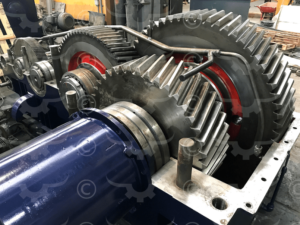Gearboxes are available in a variety of shapes, sizes, and types, making them suitable for a wide range of applications. The secret to optimizing performance and minimizing wear and tear, however, is choosing the right gearbox oil that accommodates the necessities of your specific equipment.
But what are the different gearbox oil types, and how do I know which one is right for my equipment?
In this gearbox oil guide, we’ll cover the types of gearbox oil, how to utilize viscosity charts, and everything else you need to know to better understand how to select the right oil.
What is Gearbox Oil?
Gearbox oil, otherwise known as gear oil or transmission oil, is a lubricating fluid used in mechanical gearboxes. By lubricating internal components of the gearbox, gear oil protects them from heat damage and corrosion and prevents the buildup of debris on important parts. Essentially, gearbox oil plays an important role in helping your transmission run smoothly and increasing the longevity of your equipment.
While the gearbox itself is a vital component of many applications, the gearbox oil is what helps it carry out its functions more effectively. High-performance anti-wear gear oil is created to protect against extreme pressure in gear systems, making it a valuable resource in industries like mills, factories, manufacturing plants, and refineries.
Types of Gearbox Oil
But how do I differentiate between gearbox oil types?
Just as there are different types of gearboxes, there are many variations of oils for gearboxes that optimize efficiency in each piece of equipment. The different variations of oil, each with their own unique characteristics, can be divided into three main categories: R&O, antiscuff, and compounded.
Understanding Gearbox Oil Varieties
Navigating the world of industrial gearbox oil can be complicated. Keep reading to get a better idea of the characteristics of the 3 common varieties of gearbox oil.
R&O Gear Lubricants
R&O, or rust and oxidation-inhibited gear lubricants, are specialized lubricating oils that do not contain extreme pressure additives. Their primary focus, as suggested in the name, is to prevent rust and oxidation in the gearbox. This type of oil generally performs well in terms of chemical stability, corrosion prevention, and foam suppression.
R&O oils are known for their rust prevention, oxidation resistance, lubrication, and temperature stability. This oil was designed to be used in equipment that operates at relatively high speeds, with low loads, and with uniform loading (no shock loading), and is typically compatible with a wide range of gear systems commonly found in industrial and automotive applications.
Antiscuff Gear Lubricants
Antiscuff gear lubricants, commonly referred to as extreme pressure (EP) lubricants, specialize in providing superior protection for gears in high-load and high-pressure applications. They offer extreme pressure protection, anti-scuff properties, high load capacity, temperature resistance, and reduced friction.
Due to their heavy load-carrying ability, they’re often used in machinery that undergoes extreme loads, pressures, and temperatures. A wide range of machinery falls under this category, including high-load applications, worm gears, industrial gearboxes, and automotive applications.
Compounded Gear Lubricants
Compounded gear lubricants are formulated with various additives to enhance their performance. Typically, compounded gear lubricants are mixed with a synthetic fatty acid to increase lubricity, increase film strength, and protect against rust and corrosion. However, the additives used depend on the specific needs of the intended application and may include extreme pressure additives, anti-wear additives, viscosity modifiers, detergents, and more.
Compounded gear lubricants are compatible for a wide range of applications due to their versatility.
Gearbox Oil Viscosity: Fundamentals and Grading
It’s impossible to talk about gearbox oil without mentioning the importance of viscosity. Viscosity is the measure of a fluid’s resistance to flow and is one of the most important characteristics of a lubricant. The viscosity index tells you how well a fluid can protect its viscosity during changes in temperature. Gear oil viscosity is crucial because it affects lubrication, load-carrying capacity, temperature control, film thickness, and longevity—all important factors in industrial contexts that require high resistance.
A higher viscosity translates to a thicker lubricant film, meaning it has a higher scuff load capacity and higher resistance to wear and tear. And since not all gearboxes operate the same, some may need higher levels of viscosity than others. In general, lower-viscosity gear oils are better for high-speed gearboxes with relatively low loads, while higher-viscosity oils offer better protection for slower gearboxes that operate with heavier loads and temperatures.
Common grading systems include:
- ISO VG: International Standards Organization. Established to represent a universally accepted grading system.
- AGMA: American Gear Manufacturers Association. Specifically tailored for gear lubricants.
- API: American Petroleum Institute Classification. Created to standardize and categorize gearbox oils based on their performance characteristics and suitability for specific applications.
Utilizing Gear Oil Viscosity Charts
Gear oil viscosity charts are available to help you choose the right oil, but how do you actually read them?
Overall, the importance of these charts is to help you convert different viscosity grading systems or compare the viscosity of different oils. These charts often include columns or rows that correspond to a different grading system. All you have to do is look for the viscosity grade you have or want to convert to, and then read across or down the chart (depending on the chart) to see the equivalent grades.
This helps you convert or compare easily between the different gear oil viscosity grades that we mentioned above.
Selecting the Right Gearbox Oil: Criteria and Guidelines
There are various factors that must be considered when choosing between different oils for gearboxes:
- Viscosity: Remember all the ways that viscosity affects the oil (lubrication, load-carrying capacity, longevity, etc.)? Well, now’s the time to consider your needs and choose the right level of viscosity for your equipment.
- Additives: Additives contribute to the characteristics of a specific gearbox oil, contributing to factors such as its resistance to corrosion or improved strength. Industrial gearboxes, for example, may benefit from extreme pressure additives, anti-wear additives, and friction modifiers.
- Base oil type: The base oil that you decide to use should be determined by the operating conditions, gear type, and other factors.
- Gearbox type: The type of gearbox and its specific design requirements play a huge role in determining the oil type. Check the equipment manufacturer’s recommendations and specifications to guide you in your decision.
- Operating conditions: The way in which the gearbox operates, such as the temperature, load, speed, and environment in which it works, must also be considered when choosing the right oil.
Gearbox Oil Best Practices
Maintaining the quality of your gearbox oil helps prolong the longevity of your equipment. Some of the best practices for gearbox oil include checking the oil levels regularly, inspecting for leaks, getting oil changes at the recommended time, ensuring cleanliness, and checking operating temperatures. By making these things a regular part of your routine maintenance, you can ensure optimal performance of industrial gear systems.
When and How to Change Gearbox Oil?
Some machinery has an oil life monitoring system that sends alerts when your oil is ready to be changed. For those that don’t, a good starting point is to check your manufacturer’s recommendations, which will specify how often oil should be changed depending on the type of gearbox. However, gearboxes that have heavy usage may need to be changed more often. Some of the signs that it’s ready to be changed include signs of contamination, discoloration, a burnt smell, or oil leaks around the gearbox.
To change the oil, follow these steps:
- Find the fill plug on the upper portion of the transmission housing and unscrew it.
- Find the drain plug and undo it to drain the gearbox with a catch pan underneath.
- When everything’s drained, reinstall the drain plug with a new washer and refill the transmission with the new gearbox oil. You can use a transfer pump to get the fluid into the filler hole.
- Replace the fill plug with a new washer.
And that’s pretty much it. Check for leaks and dispose of old oil, and you’re good to go.
How to Check Gearbox Oil Level
Even if you don’t see any visible signs that you should change the gearbox oil, it’s recommended to check the oil levels on a regular basis. This prevents any potential gearbox issues from occurring.
Checking the gearbox oil level can be done in 3 easy steps:
- Locate the transmission oil dipstick. You can check the manual to find where it’s at.
- Pull the dipstick out of the filler tube. Wipe it clean with a rag before moving on to the next step.
- Check the oil level. Put the dipstick back into the tube. Remove it and check the oil level on the dipstick. It should be within the acceptable range, which will be marked on the dipstick for clarity.
But as always, not every piece of machinery is created the same. Always review the manufacturer’s recommendations to ensure that you’re following the right instructions for your machinery.
Troubleshooting Common Gearbox Oil Issues
Knowing how to identify and resolve common issues related to gearbox oil helps keep your machinery in better condition for longer. Here are some of the common issues you may encounter:
- Discolored fluids: If your gearbox oil looks brown or black, then it’s a clear sign that something’s wrong. While there are multiple probabilities as to why this is happening, it’s most likely due to the oil being old or contaminated. When this happens, you should change your fluid right away to ensure that it properly lubricates the equipment.
- Low oil levels: There are many signs that your gearbox oil is low, including a burning smell, slow gear engagement, transmission leaks, noises that weren’t there before, and slipping gears. If you notice any of these signs, you can check your gearbox oil level (with the tips mentioned above) and add more oil if necessary.
- Leaking fluid: This is probably the most visible sign of an internal issue occurring. It may be due to a broken seal or gasket, a crack in the transmission casing, a broken drain seal, or loose bolts. Since there are multiple reasons this can occur, it’s recommended to inspect the gearbox to identify if any of the above possibilities are occurring. You can also take it to a professional for a thorough inspection.
Addressing Gearbox Oil Leaks
With so many potential causes, how do I address leaks?
Since there are various reasons why your gearbox may start leaking, the first step is to thoroughly inspect the gearbox yourself. Many times, the problem will present itself quickly: Notice any cracks? Worn-out parts? Loose bolts? It may even be related to the level of oil. If the oil is too high, the extra pressure may push oil through the gasket; low levels can also cause leaks due to friction.
You may be able to identify the problem at a quick glance, but other times the root of the problem may not be so clear. Some of the things you can do include:
- Check seals and gaskets
- Inspect joints
- Check for oil pathways
- Inspect ventilation
- Review operation conditions
If you don’t notice anything irregular, don’t just ignore the problem. It may be a more complex issue that should be resolved by a professional.
But aside from addressing the issue itself, there are preventative measures you can take to ensure optimal performance. We recommend getting regular gearbox inspections and maintenance, making sure your oil is always at the right level, choosing the right oil for your machine, and not prolonging any necessary repairs.
Gearbox Oil Analysis for Optimal Performance
For optimal performance, professionals can do an in-depth gearbox oil analysis to determine how your industrial gearbox is performing. This includes tests regarding viscosity, oxidation, acid number, water content, particle quantifier index, and more.
Technicians can also do a gearbox overhaul process, which involves disassembling your gearbox unit and breaking it down into separate components. They will then clean and examine each part to determine if any parts need to be repaired or replaced.
This is a more complex process than a regular inspection and should only be done when there’s severe damage or a problem with an unknown cause.
Conclusion: Maximizing Gearbox Efficiency with the Right Oil
Choosing the right oil for your gearbox is the key to optimizing performance and preventing damage. It’s also important to maintain its condition by getting regular maintenance, monitoring oil levels, and taking preventative measures. While our gearbox oil selection guide covers the basics of transmission oils, we can gladly provide further guidance on choosing the best oil for your machinery.
At Houston Pump and Gear, we provide professional gearbox repairs to guarantee optimal performance for your industrial machinery. Contact our experienced technicians if you need assistance with anything gearbox oil-related, such as leaks, gearbox overhaul services, and more.




